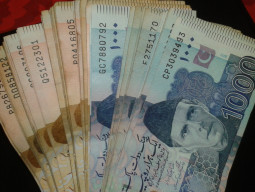
Strengthening ties and cooperation with regional countries, promoting platforms like BRICS and focusing on trade in local currencies may challenge the dominance of the US dollar in the coming years on account of a changing world order.
At present, the US has technological, economic and political dominance across the globe.
The potential diversification of foreign exchange reserves can help avert the impact of volatility in the US dollar and with the changing world scenario, countries such as Pakistan need to strengthen regional trade ties. Trade with Central Asia and the Middle East via the China-Pakistan Economic Corridor (CPEC) could benefit Islamabad to a great extent.
A recent KTrade economic insight report titled “Assessing the Future Trend of the US Dollar & Global Currency Flows,” provides a comprehensive analysis by examining the dollar’s dominance as a store of value, a safe haven and a reserve currency on the global stage along with predicting the future global financial system. It seeks to assess the potential of emerging challengers such as BRICS-plus nations to rival the dominant position of the US dollar. It also stresses the significance of the international transactions carried out by various economies in local currencies, rather than the dollar.
It has led to the growing likelihood of a parallel financial system to contest the dollar’s status as the world reserve currency. This trend is further propelled by the escalating non-dollar trade in the global oil market. The US dollar plays a pivotal role in the global financial transactions, as per the most recent SWIFT (messaging services) data for calendar year 2023. Approximately 48% of international transactions were conducted in dollars, indicating its prominence despite shifts in the geopolitical landscape.
Notably, the dollar’s utilisation through SWIFT showed a notable surge, from 42% in 2022 to 48% in 2023. The euro also commands a notable share in international payments via SWIFT, standing at 22% in 2023. Nevertheless, this represents a significant decrease from approximately 36% in 2020, resulting in an increased share of the dollar and other currencies in SWIFT transactions.
Transactions in forex markets are predominantly concentrated in the US dollar with 88% of spot, forward and swap markets featuring the dollar in one leg of the transactions in 2022. The dollar’s role as a vehicle currency for forex transactions has remained steady as it has not fallen below 87% since 2013.
The euro too has been holding a prominent share in forex turnover over the last two decades, at more than 30%. As of 2022, the share of UK pound stood at 31% while the Japanese yen held a share of 17%.
One measure of confidence in a currency, as a store of value, is its use in the official foreign exchange reserves. The dollar comprised 59% of the disclosed global official foreign reserves in 2023, far surpassing all other currencies.
The US dollar is still a dominant currency. Its share in international foreign reserves, global trade invoicing, international debt securities and cross-border loans is many times greater than the US’s share in the global gross domestic product (GDP) and international trade.
Major commodities such as oil are primarily bought and sold by using the US dollar, and some major economies, including Saudi Arabia, still peg their currencies to the dollar. In the domain of debt issuance denominated in foreign currencies, the dollar has maintained its consistent dominance, commanding a substantial share of approximately 70% since 2010. The euro’s share has remained stable at approximately 20% over the past decade.
As of 2022, the US dollar and euro collectively represented over 90% of the composition of the debt issued in foreign currency.
The international currency usage index is computed as the weighted average of five measures for which time series data is available. These include the official currency reserves, forex transaction volumes, outstanding foreign currency debt instruments, cross-border deposits and cross-border loans.
Distinguished by their burgeoning economies, the BRICS group – comprising Brazil, Russia, India, China and South Africa – has actively pursued enhanced diplomatic coordination, advocated reforms within the global financial institutions and endeavoured to serve as a formidable counterbalance to the western hegemony.
According to the projections made by the IMF, BRICS is anticipated to collectively represent approximately 27% of the global GDP by the year 2024. BRICS is considered a key challenge to the western alliance of G7 countries. G7 is estimated to account for 26.4% of the global GDP in 2023.
The BRICS coalition, anchored by the vast population exceeding 3.6 billion people, has consistently represented a formidable demographic force. With the potential addition of more nations, BRICS stands poised to surpass 50% of the global population. BRICS accounts for about 25% of the global goods exports. Given their significant presence in global trade, BRICS nations can enhance economic resilience by promoting the use of local currencies in transactions.
This strategy mitigates the risks associated with exchange rate fluctuations and reduces dependence on dollar-denominated transactions, aligning with broader efforts to fortify economic cooperation within the BRICS framework.
India is taking steps to promote the use of its own currency for international trade as part of a push to boost its exports to countries grappling with the shortage of dollars or hit with western sanctions.
India is among several countries exploring trading mechanisms that bypass the dollar, which has dominated international trade for decades. If any group that can make oil trade in non-dollar currencies possible, it is BRICS. The bloc brings together some of the world’s largest exporters of oil with some of the biggest importers. If it succeeds in shifting some of the oil trade towards other currencies, that could have a knock-on effect on the share of the US dollar in the global forex reserves.
Approximately 20% of the global oil transactions in 2023 were facilitated in currencies other than the dollar, notably as Russia and Iran supplied cargoes to different purchasers.
Following western sanctions post-Ukraine war, Russian crude oil has faced reduced demand and traded at significant discounts to global benchmarks. Despite this, India, a major importer, has continued to purchase the heavily discounted Russian crude.
Russia and Iran have finalised an agreement to trade in local currencies instead of the US dollar. Russian and Iranian banks can now use non-SWIFT messaging platforms and bilateral brokerage links to facilitate transactions in Russian ruble and Iranian rial.
Meanwhile, developing countries should benefit from the changing world outlook.
The writer is a staff correspondent
Published in The Express Tribune, April 22nd, 2024.
Like Business on Facebook, follow @TribuneBiz on Twitter to stay informed and join in the conversation.
























COMMENTS
Comments are moderated and generally will be posted if they are on-topic and not abusive.
For more information, please see our Comments FAQ